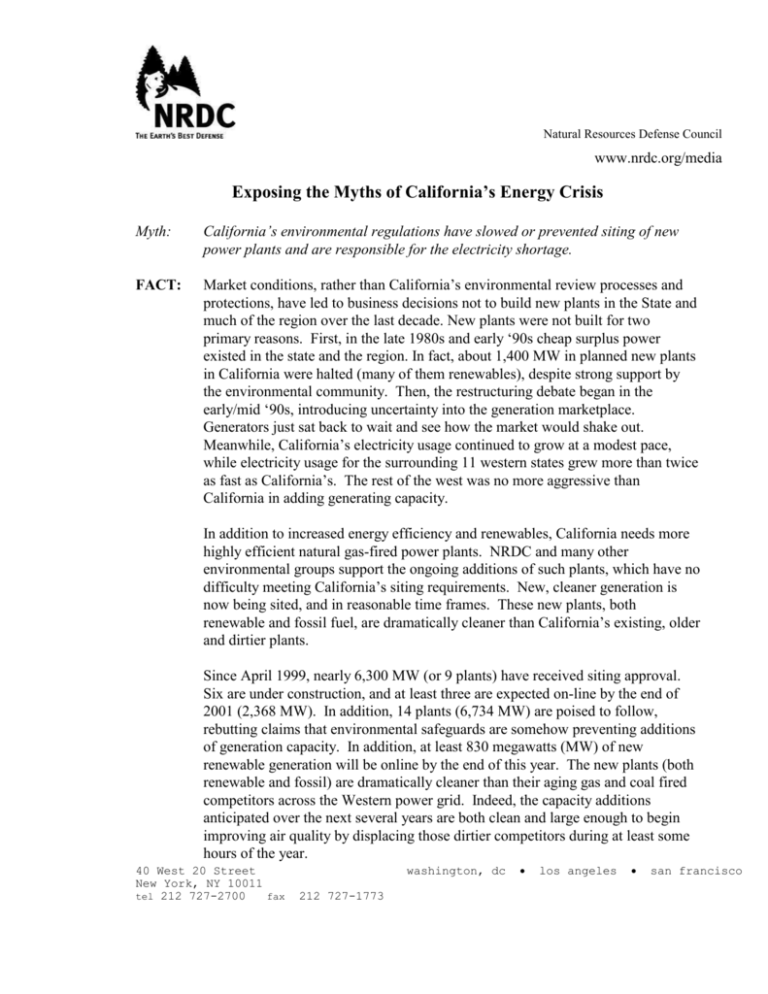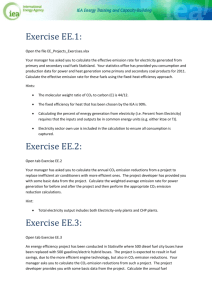Exposing the Myths of California`s Energy Crisis
advertisement

Natural Resources Defense Council www.nrdc.org/media Exposing the Myths of California’s Energy Crisis Myth: California’s environmental regulations have slowed or prevented siting of new power plants and are responsible for the electricity shortage. FACT: Market conditions, rather than California’s environmental review processes and protections, have led to business decisions not to build new plants in the State and much of the region over the last decade. New plants were not built for two primary reasons. First, in the late 1980s and early ‘90s cheap surplus power existed in the state and the region. In fact, about 1,400 MW in planned new plants in California were halted (many of them renewables), despite strong support by the environmental community. Then, the restructuring debate began in the early/mid ‘90s, introducing uncertainty into the generation marketplace. Generators just sat back to wait and see how the market would shake out. Meanwhile, California’s electricity usage continued to grow at a modest pace, while electricity usage for the surrounding 11 western states grew more than twice as fast as California’s. The rest of the west was no more aggressive than California in adding generating capacity. In addition to increased energy efficiency and renewables, California needs more highly efficient natural gas-fired power plants. NRDC and many other environmental groups support the ongoing additions of such plants, which have no difficulty meeting California’s siting requirements. New, cleaner generation is now being sited, and in reasonable time frames. These new plants, both renewable and fossil fuel, are dramatically cleaner than California’s existing, older and dirtier plants. Since April 1999, nearly 6,300 MW (or 9 plants) have received siting approval. Six are under construction, and at least three are expected on-line by the end of 2001 (2,368 MW). In addition, 14 plants (6,734 MW) are poised to follow, rebutting claims that environmental safeguards are somehow preventing additions of generation capacity. In addition, at least 830 megawatts (MW) of new renewable generation will be online by the end of this year. The new plants (both renewable and fossil) are dramatically cleaner than their aging gas and coal fired competitors across the Western power grid. Indeed, the capacity additions anticipated over the next several years are both clean and large enough to begin improving air quality by displacing those dirtier competitors during at least some hours of the year. 40 West 20 Street New York, NY 10011 tel 212 727-2700 fax washington, dc 212 727-1773 los angeles san francisco Natural Resources Defense Council www.nrdc.org/media Myth: California’s air quality and public health protections are responsible for the rolling blackouts in California. FACT: Air quality regulations are NOT responsible for rolling blackouts in California. As the Los Angeles Times noted on January 25, "California regulations have not short-circuited the amounts of electricity produced, according to power company representatives." Power plants are not being shut down because of air regulations during the Stage 3 alerts. The Times could find only one small, obsolete plant that had to suspend operations temporarily to comply with air quality standards, and it accounted for less than one-fifth of 1 percent of California’s peak power needs. In the South Coast Air Quality Management District (the region of California with the worst air quality and the strictest air regulations), the agency has reached settlements with all power plants which exceeded their emissions limits in 2000. The agreements allow them to generate beyond their current emission limits contingent on certain conditions, including the expeditious installation of emission controls, payment of fees to be used for mitigation of emissions, and deductions from future emission credit allocations. As to plants which have proposed to exceed their emissions caps in 2001, the Board has supported a staff proposal to allow these facilities to exceed their caps on similar terms to abatement orders, and will take final action on this proposal in March 2001. In the interim, the SCAQMD’s Executive Officer has adopted an executive order which has similar provisions in the short term. In other words, under these abatement orders or the executive order, power plants are being allowed to run at their full capacity. Myth: California’s air quality and public health protections are responsible for the high wholesale electricity prices of recent months. FACT: Air regulations are not the primary factor in the wholesale electricity prices. Analysis has shown that higher natural gas prices, higher demand in California, and reduced electricity imports have been more important contributors. Any price impact due to pollution control requirements is temporary and is due in large part to the failure of electricity generators, refineries and other emission sources to install cost-effective controls to meet their credit allocations. Rather than cleaning up their own sources, these entities relied on an oversupply of incredibly cheap emission credits which allowed them to defer the addition of pollution 40 West 20 Street New York, NY 10011 tel 212 727-2700 fax washington, dc 212 727-1773 los angeles san francisco Natural Resources Defense Council www.nrdc.org/media controls. The cost of these previously cheap emission credits increased dramatically in recent months in response to increasing demand, California faces a critical need to clean up existing generators in order to increase available emission credits for expanded operation of existing plants, as well as to increase emission offsets available for new generating plants. The fastest, cheapest and most reliable way to meet this need is to require existing generating facilities in California to install the best available control technologies on an aggressive schedule. This solution will clean the air, allow increased production, and lower emission credit prices for the whole market. Myth: Cost-effective emission controls require lengthy plant shutdowns and must be delayed to avoid blackouts. FACT: While care must be taken to schedule emission control installations in conjunction with planned maintenance outages, delays in installation beyond this summer are not necessary. In fact, if clean-up is delayed it will worsen the crisis next year by further reducing availability of emission offsets needed for new power sources, not to mention creating significant health concerns in the near term. Recent experience on pollution control installations in other states demonstrates that this clean-up work can be accomplished without interfering with power needs. Myth: Allowing power plant owners to pay mitigation fees in lieu of obtaining actual emission reductions will reduce pollution. FACT: Mitigation fees are not emission reductions. In fact, allowing compliance through payment of mitigation fees would likely delay (yet again) the installation of costeffective emission controls and dry up real emission reductions. Ample, costeffective opportunities exist to reduce pollution and allow increased production by cleaning up older fossil generators and the State’s many oil refineries. A SCAQMD staff assessment in their “White Paper on Stabilization of NOx RTC Prices, January 11, 2001 (p. 50) concludes that “it is possible that 3,373 tons of excess NOx RTCs will be available to the market” if NOx emissions at the South Coast refineries are fully controlled. If comparable emission reductions could be achieved at the state’s remaining refineries, significant amounts of NOx credits would become available to new power plants. To the extent that shorter term, more temporary solutions are necessary prior to these reductions being freed up, they must ensure that the offsets are quantifiable, verifiable, enforceable, real, permanent, and surplus. All cost-effective pollution reductions from major 40 West 20 Street New York, NY 10011 tel 212 727-2700 fax washington, dc 212 727-1773 los angeles san francisco Natural Resources Defense Council www.nrdc.org/media sources like power plants and refineries should be pursued (through incentives and/or mandates) before other less reliable options such as mobile sources are considered. Otherwise, we will see more pollution today with only the hope of reduced pollution tomorrow. Myth: Opening the Arctic National Wildlife Refuge or other ecologically fragile public lands to oil drilling will help resolve the California electricity crisis. FACT: Oil is not the answer to California’s electricity woes. The State’s electricity mix contains less than one percent oil. California’s electricity is produced from the following sources: 12% renewables, 20% coal (out of state generation), 20% large hydro-electric, 31% natural gas, 16% nuclear, and <1% other. Increasing production of oil would have no effect on the electricity situation in California. Besides, the California crisis is immediate and experts do not expect any oil found in new areas to reach refineries for ten years. Myth: This energy crisis is just a California problem. FACT: Reports of recent runaway growth in California electricity use are wildly exaggerated; the estimated statewide increase for 2000 was about 3.5 percent, and the annual rate of growth from 1990-98 was less than 1 percent. California accounts for only about 15 percent of the increase in Western peak power use since 1995, although the state represents more than 40 percent of the total system; in other words, electricity consumption for the other ten western states has been growing more than twice as fast as California’s, on average. The efficiency and renewable-energy imperatives apply at least as strongly outside California's boundaries; electricity consumption for the nation as a whole increased by 22 percent from 1990-99, double California's 11 percent figure for the same period. Myth: Increased use of emergency or other diesel generators is necessary to provide increased power in the short term. Fact: Increased use of diesel generators will pose a serious public health threat to California communities and cleaner options are available. Diesel exhaust has been listed as a known carcinogen under Proposition 65 since 1990. In 1998, the California Air Resources Board (CARB) listed diesel exhaust as a toxic air contaminant and concluded that it is responsible for more than 70 percent of the cancer risk from air pollution statewide. This estimate is based on current use of 40 West 20 Street New York, NY 10011 tel 212 727-2700 fax washington, dc 212 727-1773 los angeles san francisco Natural Resources Defense Council www.nrdc.org/media diesel engines in California -- increased use of the diesel generators will increase this serious risk. According to estimates from CARB, one typical uncontrolled one megawatt diesel generator operated only during peak demand (250 hours per year) would result in a 50% increase in cancer risk due to diesel exhaust exposures for nearby residents. There are already 11,000 emergency diesel generators statewide. Diesel generators also emit much higher levels of oxides of nitrogen (NOx) than comparable natural gas engines. Therefore, increased use of diesel generators will threaten the ability of many regions in California to meet their deadlines for attainment with federal air quality standards. Cleaner burning alternatives, such as natural gas turbines, are readily available to solve our current electricity shortfall and have much lower emissions. For example, the dirtiest natural gas turbine is 96% cleaner than the cleanest diesel generator. While advocates for increased use of diesel generators argue that the natural gas alternatives are not readily available, sellers of the natural gas microturbines have promised prompt delivery of their engines – 45 to 90 days from purchase (Capstone) or 2-3 weeks (Honeywell). In the case of larger natural gas turbines (1.2 to 13.5 MW), customers can receive their units in 20 weeks, with 4-6 weeks to follow for installation (Solar Turbines). Diesel generators should not be used to meet the State’s electricity shortfall in electricity supply. We cannot allow the current power shortage to compromise the health and lives of California residents -- particularly when there are cleaner options available. 40 West 20 Street New York, NY 10011 tel 212 727-2700 fax washington, dc 212 727-1773 los angeles san francisco









